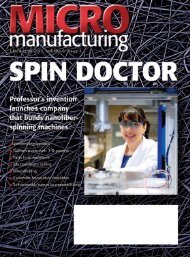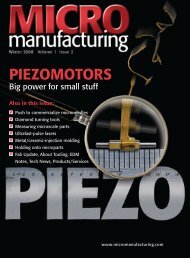to view as PDF - MICROmanufacturing
to view as PDF - MICROmanufacturing
to view as PDF - MICROmanufacturing
Create successful ePaper yourself
Turn your PDF publications into a flip-book with our unique Google optimized e-Paper software.
SWISSmachining By Kip Hanson,<br />
Contributing Edi<strong>to</strong>r<br />
Microboring: when drilling just won’t cut it<br />
20 | MAY/JUNE 2012 | <strong>MICROmanufacturing</strong><br />
If the edi<strong>to</strong>r doesn’t change the font size on<br />
me, the period at the end of this sentence<br />
me<strong>as</strong>ures about 0.02" (0.5mm) across. It’s<br />
<strong>to</strong>ugh <strong>to</strong> drill something that small or smaller,<br />
but with a modern CNC Swiss-style machine<br />
and the right drill bit, it’s doable.<br />
But what if your cus<strong>to</strong>mer wants a coupletenths<br />
<strong>to</strong>lerance on that hole or an ultrafine<br />
surface finish? Could you bore it?<br />
You might if you could find a <strong>to</strong>ol that<br />
small. The boring bar would have <strong>to</strong> be<br />
smaller than a 12-lb. fishing line, and even<br />
if bars that small were made, they would be<br />
hellishly expensive, right? Not really.<br />
Utilis quick-change boring system.<br />
GenSwiss<br />
Dale Chris<strong>to</strong>pher, president of Scientific<br />
Cutting Tools, Simi Valley, Calif., noted that<br />
most of the small boring bars his company<br />
offers cost less than a pair of movie tickets and<br />
a bag of popcorn.<br />
“A bar like a 1-8-5 (0.185" minimum bore) is<br />
in the $23 range,” he said.<br />
OK, but what if I need an ultr<strong>as</strong>mall<br />
bar, one that could cut the cataracts out of<br />
a bumblebee? Chris<strong>to</strong>pher consulted his<br />
catalog. “Our smallest goes down <strong>to</strong> 0.015",<br />
with a maximum depth of 0.05". That one’s<br />
$28.74. It goes up a little because of how small<br />
it is. They’re a bit harder <strong>to</strong> set up.”<br />
A bit harder <strong>to</strong> set up? The failure rate<br />
must be awfully high, grinding something that<br />
small. “It’s not so much a high failure rate <strong>as</strong><br />
it is having <strong>to</strong> scrap out a few before you get<br />
going,” said Chris<strong>to</strong>pher. “We make all our<br />
<strong>to</strong>ols in-house on Rollomatic CNC grinders.<br />
When you set up your machine, you me<strong>as</strong>ure<br />
your wheels <strong>as</strong> accurately <strong>as</strong> you can, but the<br />
first <strong>to</strong>ol never is going <strong>to</strong> come out exactly<br />
right. So you throw that <strong>to</strong>ol away, adjust your<br />
machine and then you cut another. By the third<br />
one, you should have everything dialed in.”<br />
‘The first <strong>to</strong>ol never is going<br />
<strong>to</strong> come out exactly right.<br />
By the third one, you should<br />
have everything dialed in.’<br />
So dialing in the grinding machine <strong>to</strong> make<br />
these <strong>to</strong>ols is no big deal, but what about<br />
dialing in the lathe the <strong>to</strong>ol runs on? You can<br />
forget about achieving proper surface speed—<br />
boring a 0.015" hole at even 200 sfm means<br />
main-spindle speeds of over 50,000 rpm.<br />
Boring at those speeds is just not possible.<br />
And how do you find centerline when you can<br />
barely even see the <strong>to</strong>ol?<br />
Again, Chris<strong>to</strong>pher explained, it’s not <strong>as</strong><br />
<strong>to</strong>ugh <strong>as</strong> it sounds. “Our <strong>to</strong>ols have a small<br />
locating flat on the <strong>to</strong>p of the boring bar, and<br />
we also offer sleeves with a backs<strong>to</strong>p. So,<br />
after you qualify the boring bar—usually on a<br />
presetter or by using turret-mounted gages—<br />
you can just take them in and out. You’ll be<br />
real close.” And what about proper cutting<br />
speed? “That’s limited by the machine <strong>to</strong>ol. So<br />
you just have <strong>to</strong> crank up your spindle <strong>as</strong> f<strong>as</strong>t<br />
<strong>as</strong> it will go and take light cuts, and that’s the<br />
best you can do.”<br />
Chris<strong>to</strong>pher also suggested using <strong>to</strong>ols<br />
coated with TiAlN, which improves <strong>to</strong>ol wear<br />
while retaining edge sharpness. “The nonstick<br />
surface reduces edge buildup when you don’t<br />
have the proper surface footage. Also, we use<br />
a premium, submicron-grain carbide and put















